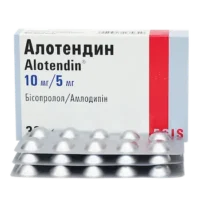Description
Izoptin SR Tablets with Prolonged Release 240 mg. №30
Ingredients:
Each tablet contains 240 mg of Verapamil Hydrochloride.
Mechanism of Action:
Verapamil, a calcium channel blocker, inhibits the influx of calcium ions into cardiac and smooth muscle cells, leading to vasodilation and decreased myocardial contractility. This results in reduced heart rate, blood pressure, and oxygen demand by the heart.
Pharmacological Properties:
Verapamil Hydrochloride exerts its effects by blocking calcium channels in the heart and blood vessels, leading to vasodilation, decreased cardiac contractility, and improved oxygen supply to the heart muscle.
Indications for Use:
Izoptin SR tablets are indicated for the treatment of hypertension, stable angina pectoris, and certain types of cardiac arrhythmias, including atrial fibrillation and paroxysmal supraventricular tachycardia.
Contraindications:
Do not use Izoptin SR if you have a known hypersensitivity to Verapamil or other components of the formulation. Avoid in patients with severe left ventricular dysfunction, hypotension, sick sinus syndrome, or conduction abnormalities such as AV block.
Side Effects:
Common side effects of Izoptin SR may include constipation, dizziness, headache, edema, and bradycardia. Rare but serious side effects may include heart block, worsening heart failure, and allergic reactions.
Usage Instructions:
The usual recommended dosage of Izoptin SR is one tablet (240 mg) taken orally once daily, preferably in the morning. The tablet should be swallowed whole with a full glass of water, without chewing or crushing.
Benefits Compared to Analogues:
Izoptin SR offers the advantage of once-daily dosing due to its prolonged-release formulation, providing consistent blood levels of Verapamil and sustained therapeutic effects throughout the day. This may improve patient adherence to treatment regimens and optimize cardiovascular outcomes.
Suitable Patient Groups:
Izoptin SR can be used in adult patients with hypertension, angina, or certain arrhythmias. Special caution is advised when prescribing to elderly patients due to age-related changes in drug metabolism and potential interactions with other medications. Use in pediatric patients should be determined by a healthcare provider based on individual considerations.
Storage and Shelf Life:
Store Izoptin SR tablets at room temperature (20-25°C) in a dry place, away from direct sunlight and moisture. Keep the tablets in their original packaging to protect from light. Check the expiration date on the packaging and do not use the product after the stated shelf life.
Packaging Description:
Izoptin SR tablets are supplied in blister packs of 30 tablets each. The packaging is designed to maintain the integrity and stability of the tablets, protecting them from environmental factors that may affect their quality.
Scientific Evidence:
Studies have shown that Verapamil, the active ingredient in Izoptin SR, effectively reduces blood pressure, improves coronary blood flow, and helps control cardiac arrhythmias. Clinical trials have demonstrated the efficacy and safety of Izoptin SR in the management of various cardiovascular conditions, supporting its use in clinical practice.
Additional Information:
Regular monitoring of blood pressure, heart rate, and electrocardiogram parameters is essential during treatment with Izoptin SR to ensure therapeutic efficacy and safety. Patients should be advised to report any unusual symptoms or side effects to their healthcare provider promptly. Consultation with a healthcare professional is recommended before initiating treatment with Izoptin SR to establish an individualized dosing plan and assess potential drug interactions.





